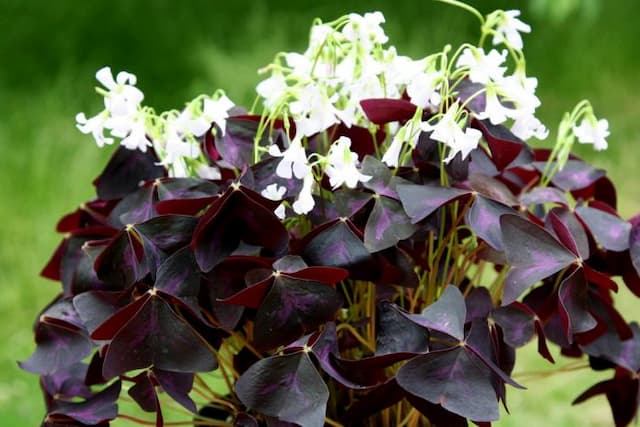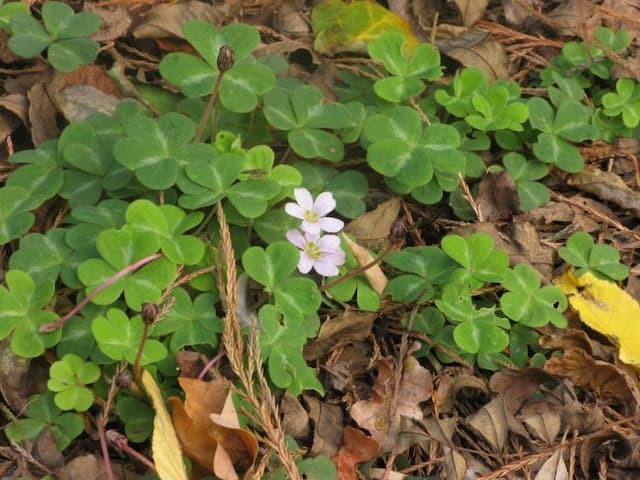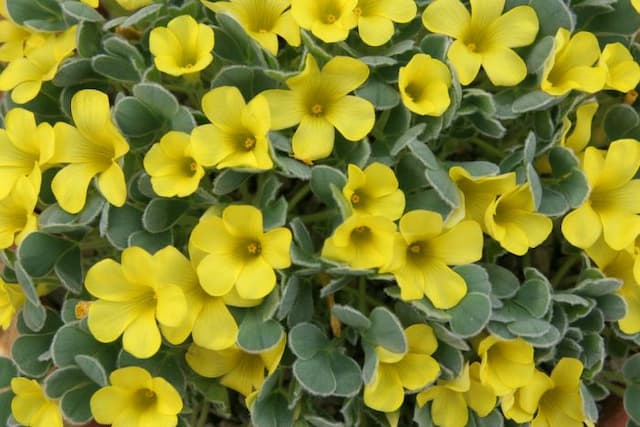Gold Cape Sorrel Oxalis massoniana

ABOUT
The plant known as Oxalis massoniana, more commonly referred to as "Gold Cape sorrel," showcases a charming and ornamental appearance, often admired in gardens for its vibrant and cheerful demeanor. The plant bears heart-shaped leaves, which are typically a rich green, creating a lush backdrop for its key attraction: the bright, golden-yellow flowers. These flowers are distinct and cup-shaped, with five delicate petals that curl gracefully outwards, providing a pop of color that catches the eye. The leaves of Gold Cape sorrel are arranged in a trifoliate pattern, which means they are grouped in clusters of three, somewhat resembling a clover. This leaf arrangement gives the plant a full and textured look, creating an appealing contrast with the soft, open flowers. The overall foliage has a slightly glossy finish, further enhancing its visual appeal. During certain times of the day, or when the plant is exposed to changes in light or temperature, the leaves exhibit an intriguing behavior: they can fold up and close, reacting to the environmental conditions. This movement adds a dynamic aspect to the otherwise static display of garden plants. Gold Cape sorrel's flowers are borne on slender stems that rise above the foliage, giving the blooms a floating appearance amidst the greenery. The flowers come to life mainly during the spring season, often adding a touch of warmth to the surrounding landscape with their sunny coloration. As with many ornamental plants, Gold Cape sorrel requires attention with regard to its growing conditions to maintain its attractive presence, but regardless of these needs, it remains a delightful addition to any setting that seeks to capture the radiant beauty of nature.
About this plant
 Names
NamesFamily
Oxalidaceae
Synonyms
Gold Cape Oxalis, Masson's Wood Sorrel
Common names
Oxalis cernua, Oxalis bowiei, Oxalis pes-caprae var. bowiei, Oxalis cernua var. massoniana, Oxalis massonorum.
 Toxicity
ToxicityTo humans
Oxalis massoniana, more commonly known as the 'False Shamrock' or 'Wood Sorrel,' is generally considered non-toxic to humans when consumed in small quantities. However, it contains oxalic acid, which in larger amounts can lead to toxicity. Consuming significant amounts of the plant can result in symptoms such as kidney stones, nausea, vomiting, diarrhea, and in severe cases, kidney failure. Oxalic acid can also interfere with the absorption of calcium, leading to nutrient deficiencies if consumed in large amounts over time.
To pets
False Shamrock or Wood Sorrel is toxic to pets due to its content of oxalic acid and soluble oxalates. If ingested by pets such as dogs and cats, it can cause symptoms like vomiting, diarrhea, lethargy, and tremors. In severe cases, ingestion can lead to kidney failure or even death. It is crucial to keep pets away from this plant and seek veterinary care immediately if there is suspicion of ingestion.
 Characteristics
CharacteristicsLife cycle
Perennials
Foliage type
Deciduous
Color of leaves
Green
Flower color
Yellow
Height
0.5 feet (15 cm)
Spread
0.5 feet (15 cm)
Plant type
Bulb
Hardiness zones
7
Native area
South Africa
Benefits
 General Benefits
General Benefits- Aesthetic Appeal: Oxalis massoniana, commonly known as the "Gold Cape oxalis," adds vivid color and a unique clover-like leaf shape to gardens, enhancing visual interest.
- Easy to Grow: The plant is low-maintenance, adapting to a wide range of soils and can be easily grown in pots or gardens.
- Bee-Friendly: Gold Cape oxalis flowers attract bees, supporting local pollinators which are essential for healthy ecosystems.
- Edible Parts: Some species of Oxalis are known to have edible leaves and bulbs that can be used in salads and cooking, adding a sour, lemony flavor.
- Ground Cover: Due to its dense growth habit, it can act as a ground cover, which helps to suppress weeds and protect the soil from erosion.
- Shade Tolerance: It thrives in both sunny and partly shaded areas, making it versatile for different garden spots.
 Medical Properties
Medical PropertiesThis plant is not used for medical purposes.
 Air-purifying Qualities
Air-purifying QualitiesThis plant is not specifically known for air purifying qualities.
 Other Uses
Other Uses- The sour-taste of the Oxalis massoniana leaves can be used as a lemon flavor substitute in recipes when citrus is unavailable or for a different twist on traditional dishes.
- The leaves and flowers could be used for their aesthetic value as natural confetti at events as they are colorful and biodegradable.
- Extracts from the plant might be used as a natural pH indicator for educational purposes, with its color changes in different pH levels similar to the properties of red cabbage.
- Due to its resilient nature, Oxalis massoniana can be planted in areas prone to erosion to help stabilize the soil with their root system.
- In crafts, the bright yellow flowers can be pressed and included in homemade paper to create a decorative, natural look.
- Its growth habit can be a useful addition to living roofs or green roofs, contributing to urban biodiversity and insulation properties.
- The plant can be cultivated as part of a children's garden project to teach about plant life cycles and the care needed to grow a living organism.
- Oxalis massoniana might be used in landscape design to provide a low maintenance cover that bursts with yellow flowers during its blooming season.
- Can act as a companion plant in vegetable gardens, potentially deterring certain pests due to its sour taste and aiding in the growth of other plants.
- It can be part of a natural dye collection process for hobbyists or artists looking to extract yellow pigments from the flowers.
Interesting Facts
 Feng Shui
Feng ShuiThe Oxalis, or more commonly known as shamrock or wood sorrel, is not typically associated with Feng Shui practice.
 Zodiac Sign Compitability
Zodiac Sign CompitabilityThe Oxalis, or more commonly known as shamrock or wood sorrel, is not used in astrology practice.
 Plant Symbolism
Plant Symbolism- Luck - Oxalis massoniana, commonly known as Wood Sorrel, often symbolizes luck due to its clover-like leaves, which are reminiscent of the lucky four-leaf clover.
- Joy - The bright, typically yellow flowers of the Wood Sorrel are associated with joy and happiness.
- Resilience - Wood Sorrel can thrive in a variety of conditions, making it symbolic of resilience and the ability to adapt.
 Water
WaterThe Gold Cape Oxalis requires moderate watering; aim to keep the soil consistently moist but not waterlogged. Water thoroughly when the top inch of soil feels dry to the touch, which might be approximately every 7-10 days, depending on environmental conditions. Use enough water to saturate the soil until it begins to drain from the bottom of the pot, which could be around 8-16 ounces for smaller pots. During their dormant period in the summer, reduce watering significantly to simulate their natural habitat, allowing the soil to dry out completely before watering lightly.
 Light
LightGold Cape Oxalis thrives in bright, indirect sunlight. A spot that receives morning sun followed by dappled shade or filtered light throughout the day is ideal. Direct afternoon sunlight should be avoided as it can cause the leaves to scorch. A north-facing or east-facing window is often a good location for this plant, providing it with the gentle light it prefers.
 Temperature
TemperatureGold Cape Oxalis favors a temperate range between 60°F and 75°F. It can survive in temperatures as low as 50°F and as high as 80°F, but the ideal conditions are within the moderate range. Extreme temperatures, both hot and cold, should be avoided to keep the plant healthy.
 Pruning
PruningPruning Gold Cape Oxalis is primarily for aesthetic purposes and to remove any spent flowers or damaged foliage. Prune lightly throughout the growing season as needed to maintain shape and encourage bushier growth. The best time for more extensive pruning is in late winter or early spring, just before new growth begins. Pruning is not frequently required but can rejuvenate an older plant.
 Cleaning
CleaningAs needed
 Soil
SoilThe Gold Cape Oxalis prefers well-draining soil with a mix of potting soil, perlite, and peat with a pH range from 6.0 to 6.5 to thrive and flourish.
 Repotting
RepottingGold Cape Oxalis should be repotted every 2 to 3 years or when it outgrows its current pot to ensure continued growth and health.
 Humidity & Misting
Humidity & MistingGold Cape Oxalis flourishes best in moderate humidity levels around 50% but is quite adaptable to the typical indoor environment.
 Suitable locations
Suitable locationsIndoor
Place Gold Cape Oxalis in bright, indirect light and well-draining soil indoors.
Outdoor
Plant Gold Cape Oxalis in partial shade and protect from harsh sun.
Hardiness zone
7-10 USDA
 Life cycle
Life cycleOxalis massoniana, commonly known as Masson's Woodsorrel, begins its life cycle as a seed, which upon favorable conditions of moisture and temperature, germinates and develops into a seedling. The seedling then grows into a juvenile plant, characterised by the development of true leaves, distinct from the initial embryonic cotyledons. As it matures, the plant forms a bulb-like structure, which serves as an underground storage organ. During its adult stage, Masson's Woodsorrel produces distinctive trifoliate leaves and bright yellow flowers, capable of both sexual reproduction via pollination and asexual reproduction through bulbils in some cases. After pollination, seeds are set within capsules that, when dry, can explosively discharge seeds, ensuring dispersal. Following seed dispersal, the plant enters a period of dormancy, with the underground bulbs able to survive adverse conditions until the next favorable growth cycle.
 Propogation
PropogationPropogation time
Spring to Summer
Propogation: The most popular method of propagating Oxalis massoniana, commonly known as Gold Cape Oxalis, is through division of its bulbs. This is usually carried out in the fall, after the plant has finished blooming and has begun to go dormant. To propagate, gently lift the clumps of bulbs from the ground using a spade, taking care not to damage them. Once they are out of the soil, brush off any excess dirt and separate the bulbs by hand, ensuring that each division has at least one growth point. These individual bulbs can then be replanted immediately at a depth of approximately 1 inch (2.54 centimeters) with the pointed end facing upwards, spaced about 4 to 6 inches (10 to 15 centimeters) apart to allow for adequate growth. Water the newly planted bulbs lightly to settle the soil around them and to initiate root development.




